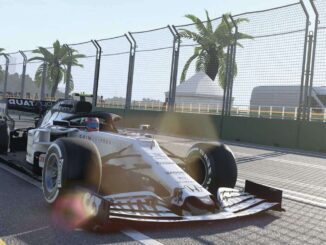
An in-depth guide to help you create and adapt setups across tracks and conditions.
F1 Engineering – Creating and Adapting Setups
In the sport where every thousandth of a second counts, it’s imperative teams, engineers and drivers extract every increment of time possible from the car. In Formula 1 2020, you are all three and thus to emulate the greats, you must understand how to setup a car.
On Michael Schumacher, Niki Lauda said, “He was the perfect racer, with speed, instinct and a great technical understanding.”
This guide will bolster your technical understanding.
Overview
In Formula 1 2020 you can alter several different components of your car.
These include:
- Fuel load
- Aerodynamics
- Transmission
- Suspension geometry
- Suspension
- Brakes
- Tyres
There is no one perfect setup since factors like weather condition, track, and driver style will influence the performance. Moreover, each car is modelled differently so specifications like rake will vary. It’s important to know how to adapt your setup to these conditions, and in some circumstances, during the race.
In Formula 1 you may tinker with your car to your heart’s content throughout the three practice sessions which precede the race. Use P1, P2 and P3 to find a setup which works for you. Test different setups and see how the car handles and responds.
Once the car has left the garage in Qualification, you are subject to Parc fermé and the number of elements you can change on the car falls.
The elements you can change include:
- Fuel Load
- Front Wing Aero
- On-throttle Differential
- Front Brake Bias
It is important to monitor the weather for the race and include the forecast into your qualification setup, since you won’t be able to change elements not mentioned above.

The Car Keeps Spinning (Oversteer)
Oversteer refers to the motion of a car turning beyond the relative steering-input, causing the car to lose traction and eventually spin.
To correct oversteer:
- Stiffen (increase value) the Front Anti-Roll Bar
- Soften (decrease value) the Rear Anti-Roll Bar
- Increase Differential Lock
- Stiffen the Front Suspension
- Soften the Rear Suspension
- Set Brake Bias Forward
- Adjust the Rear Tyre Pressures*
The Car Won’t Turn (Understeer)
Understeer refers to the motion of a car turning less than the relative steering-input, causing the car to miss the corner apex and travel deeper into the corner.
To correct Understeer:
- Soften (decrease value) the Front Anti-Roll Bar
- Stiffen (increase value) the Rear Anti-Roll Bar
- Decrease Differential Lock
- Soften the Front Suspension
- Stiffen the Rear Suspension
- Set Brake Bias to the Rear
- Increase Wing Aero
- Adjust the Rear Tyre Pressures*
The Car is Slow (Aero)
Get out the Haas.
A car’s aerodynamics determine how fast it can corner and the vehicle’s drag profile. Optimum aerodynamics should be at as low an angle as possible without impeding on the traction and cornering ability.
Conversely, setting the aero angle higher will increase downforce, improving grip, but will significantly impact straight-line speed.
Therefore, aerodynamics values are highly track specific. Monza (Italy) features several long straights and thus you want to have a low aero angle.
Monte Carlo (Monaco) is a tight track with slow corners and thus you want to have a higher aero angle.
Similarly, altering the car’s Ride Height will affect the drag profile.
Decreasing the Ride Height will reduce drag and increase the car’s straight-line speed, negatively affecting downforce.
Increasing the Ride Height will increase drag and reduce the car’s straight-line speed, positively affecting downforce.
The Wheels Keep Locking Up (Braking)
The wheels lock up when the braking load exceeds the car’s stopping power.
To reduce the chance of lock ups:
- Reduce Brake Pressure
Traveling uphill (USA T1) will reduce the distance required when braking.
Traveling downhill (Austria T9) will increase required when braking.
The Tyres Are Degrading Too Fast (Pressures)
Tyre degradation (the rate at which they lost traction) is affected by driving style, pace, track position, temperature and tyre compound.
While the first two factors are individual to the driver and aren’t technical issues, the latter three aren’t.
Because cars stick to the racing line, their excess rubber (marbles)—shed as the tyre degrades—collects outside this line. Driving off the line will cause your tyres to collect these marbles, making the wear uneven, increasing degradation.
Hotter temperatures—and increased loads—will cause the tyre to degrade faster.
On a given race weekend, providing conditions are dry, you are given a choice of three tyres. Soft, Medium and Hard. The Soft tyres are the fastest to reach optimum temperature and offer the fastest times but will degrade the quickest of the three compounds.
Hard tyres are slower to reach their optimum temperature and offer the slowest times but have the longest life.
Medium tyres are a combination of both.
*In F1 2020 you can adjust the pressure of individual tyres. Factors such as track and temperature will affect how you should adapt the tyre pressure.
For example:
The Red Bull Ring (Austria) has seven right-hand turns, and three left-hand turns. When cornering, the greatest load will be placed on the outside tyre, meaning at this track, the left-sided tyres—in particular the front left—will degrade faster than the right-sided tyres.
The opposite is true.
Interlagos (Brazil) has nine left-hand turns, and six right-hand turns. At this track, the right-sided tyres—in particular the front right—will degrade faster than the left-sided tyres.
As a car goes through a corner, the load placed on the outer tyre will cause it to increase in temperature, thereby increasing the rate at which is degrades. Tyres under the greatest load (Left in Austria, Right in Brazil) should have a lower pressure than inner tyres to compensate.
Wet Weather Racing
Rain drastically alters the track conditions and how the car performs. The wheels will have less traction—partially compensated for by tyre compounds—and the aerodynamics will shift.
To adjust for rain you should:
- Decrease the Brake Pressure
- Raise the Ride Height
- Increase Wing Aero
- Stiffen (Increase value) the Suspension
- Increase Tyre Pressures*




Be the first to comment